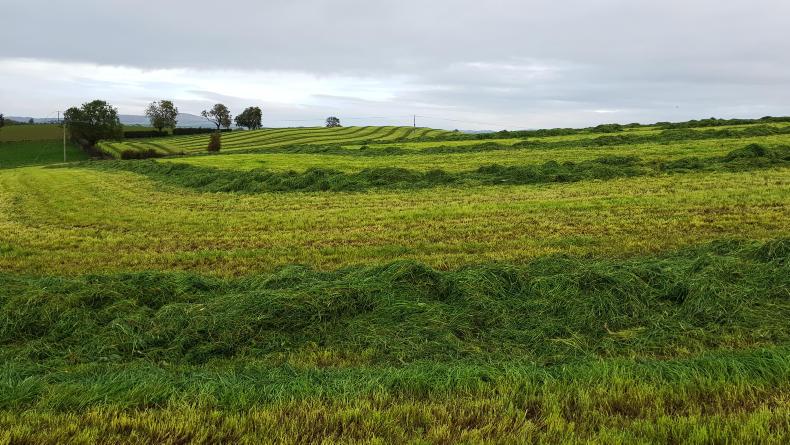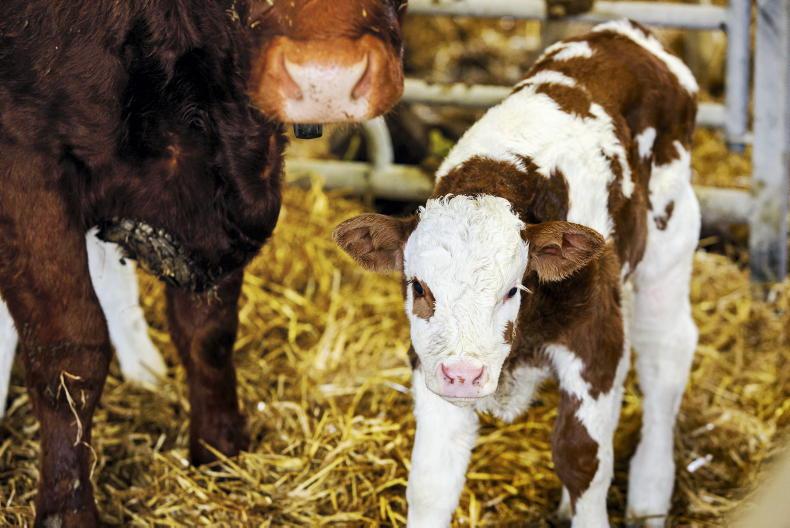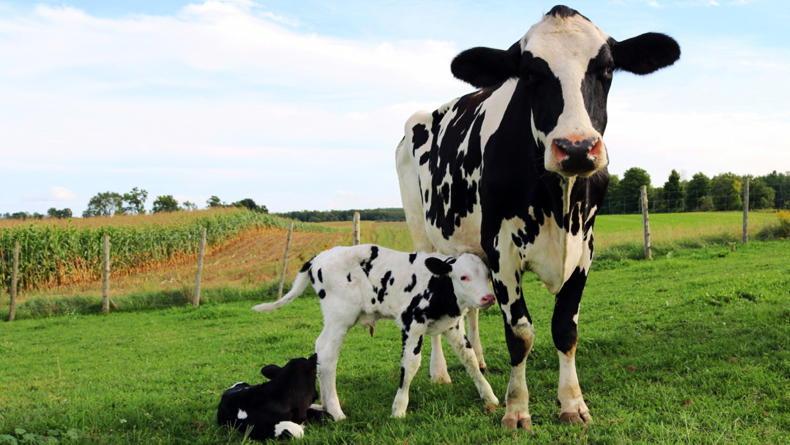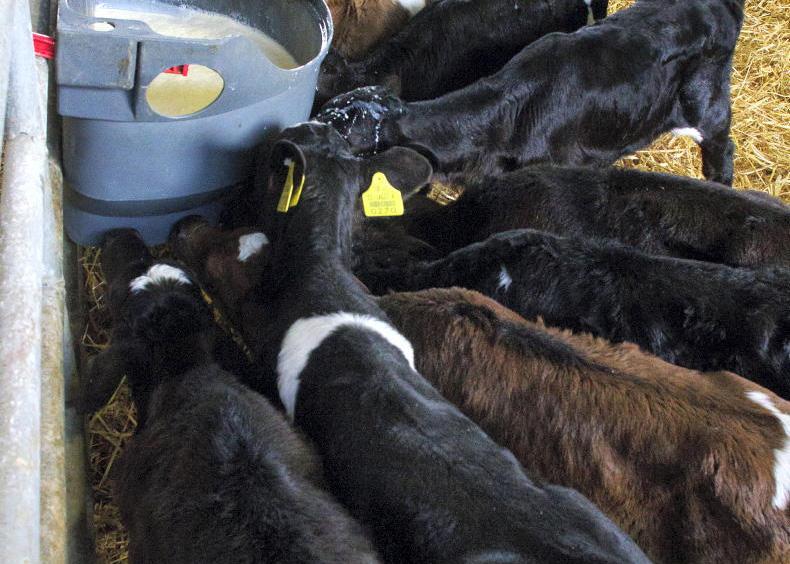Calving is ongoing on Dairylink Ireland programme farms and cows that are due to calve down in December and January are being dried off at present.
Good ground conditions and grass supplies on programme farms mean that dry cows are generally out grazing until a few weeks before calving. Cows are then housed and are fed haylage or lower-quality silage, plus pre-calving minerals or dry cow nuts.
Dairylink adviser Conail Keown points out that concentrates are not necessary during the dry period if body condition score is on target.
Although, concentrates for dry cows can have a role to play if fodder supply is an issue on individual farms this winter.
Conail said that if body condition is below the target of 2.5 to 3.0, an extended dry period is better than trying to build condition through increased concentrate feeding.
He is also advising farmers to avoid over-conditioning by using straw or other low energy feeds in diets if only good-quality silage is available.
He says that for cows that are on target with body condition, pre-calving minerals should be fed twice a day on top of silage from four to six weeks before calving. Mineral buckets can be used when dry cows are at grass, but are not ideal as the only source of pre-calving minerals during the dry period, as individual intakes are not reliable.
Based on a daily feed rate of 100g of minerals per cow, Conail says that cows should be getting 4g phosphorous, 15g sodium and 25g magnesium. Trace elements should also be included in dry cow diets, such as copper, selenium, iodine, cobalt and manganese.
Inadequate mineral intake during the dry period can result in milk fever, retained cleanings and subsequent fertility problems.
Weekly roundup
Slurry is being spread on Dairylink Ireland farms ahead of the closed period.Calving and calf rearing is ongoing on programme farms.Cows are being treated for fluke and worms at drying off.Intakes of major and trace elements are being managed through pre-calving minerals or dry cow nuts.Farmer focus: Richard Marshall, Omagh, Co Tyrone
We run a Holstein Friesian herd near Omagh, Co Tyrone. I farm with my father John and I have been working at home full-time since I finished college in 2015.
Average yield is 8,900 litres from 3.1t of concentrates. There are 130 acres surrounding the yard and another 70 acres of an outfarm about a mile away.
We mowed 70 acres of fourth-cut silage on Saturday and it was ensiled on Monday. Most of it fitted into a pit on the outfarm and the last 12 acres were made into bales. Slurry is being spread on the silage ground this week by a local contractor using an umbilical system.
We narrowed the interval slightly between first-, second- and third-cuts of silage this year to around five weeks to improve silage quality. All silage has been made in good conditions this year and looks to be good quality. We have some samples away getting analysed at present ahead of winter feed planning.
Milking cows are housed at night and are on second-cut silage, 1kg of straw nuts and 3kg blend. Cows are then fed to yield in the parlour and between blend and in-parlour feeders they are on 6.5kg/cow/day on average at present.
There are 24 heifers that have calved down in the past few weeks. Heifers were housed on an outfarm during last winter and were on a synchronisation programme.
Sexed semen was used on some heifers and calves born this autumn are sired by bulls such as Molloy, Doorman and Perseus.
Dry cows
Stale cows are being dried off every week and will be calving from now to April. At drying off, cows get a pour-on for roundworms and lungworms and a drench for fluke.
Dry cows are at grass with access to mineral buckets until three or four weeks before calving. They are then housed and fed lower-quality baled silage and 2kg/cow/day of a dry cow blend.
We have plenty of silage this year between the good summer and being down in stock numbers due to a TB breakdown.
There are 85 cows milking at present, but milk output is a lot lower than it should be because in-calf heifers and early autumn-calving cows went down as reactors earlier this year.
There was 35 acres reseeded this autumn, with some done five weeks ago and another area was reseeded two weeks later.
Both lots were a full conventional reseed and have struck well. There is some chickweed coming, so it will be hit with a pre-emergence spray shortly. The reseed will probably get a light grazing by some sheep later in the autumn to thicken the sward.
We are getting set up to start grass measuring to improve grassland management during the grazing season. The farm has been mapped out and paddocks have been given names and numbers. We will start measuring with a plate meter for the remainder of this season and will hopefully have the hang of it for weekly measuring starting from next spring.
Calving is ongoing on Dairylink Ireland programme farms and cows that are due to calve down in December and January are being dried off at present.
Good ground conditions and grass supplies on programme farms mean that dry cows are generally out grazing until a few weeks before calving. Cows are then housed and are fed haylage or lower-quality silage, plus pre-calving minerals or dry cow nuts.
Dairylink adviser Conail Keown points out that concentrates are not necessary during the dry period if body condition score is on target.
Although, concentrates for dry cows can have a role to play if fodder supply is an issue on individual farms this winter.
Conail said that if body condition is below the target of 2.5 to 3.0, an extended dry period is better than trying to build condition through increased concentrate feeding.
He is also advising farmers to avoid over-conditioning by using straw or other low energy feeds in diets if only good-quality silage is available.
He says that for cows that are on target with body condition, pre-calving minerals should be fed twice a day on top of silage from four to six weeks before calving. Mineral buckets can be used when dry cows are at grass, but are not ideal as the only source of pre-calving minerals during the dry period, as individual intakes are not reliable.
Based on a daily feed rate of 100g of minerals per cow, Conail says that cows should be getting 4g phosphorous, 15g sodium and 25g magnesium. Trace elements should also be included in dry cow diets, such as copper, selenium, iodine, cobalt and manganese.
Inadequate mineral intake during the dry period can result in milk fever, retained cleanings and subsequent fertility problems.
Weekly roundup
Slurry is being spread on Dairylink Ireland farms ahead of the closed period.Calving and calf rearing is ongoing on programme farms.Cows are being treated for fluke and worms at drying off.Intakes of major and trace elements are being managed through pre-calving minerals or dry cow nuts.Farmer focus: Richard Marshall, Omagh, Co Tyrone
We run a Holstein Friesian herd near Omagh, Co Tyrone. I farm with my father John and I have been working at home full-time since I finished college in 2015.
Average yield is 8,900 litres from 3.1t of concentrates. There are 130 acres surrounding the yard and another 70 acres of an outfarm about a mile away.
We mowed 70 acres of fourth-cut silage on Saturday and it was ensiled on Monday. Most of it fitted into a pit on the outfarm and the last 12 acres were made into bales. Slurry is being spread on the silage ground this week by a local contractor using an umbilical system.
We narrowed the interval slightly between first-, second- and third-cuts of silage this year to around five weeks to improve silage quality. All silage has been made in good conditions this year and looks to be good quality. We have some samples away getting analysed at present ahead of winter feed planning.
Milking cows are housed at night and are on second-cut silage, 1kg of straw nuts and 3kg blend. Cows are then fed to yield in the parlour and between blend and in-parlour feeders they are on 6.5kg/cow/day on average at present.
There are 24 heifers that have calved down in the past few weeks. Heifers were housed on an outfarm during last winter and were on a synchronisation programme.
Sexed semen was used on some heifers and calves born this autumn are sired by bulls such as Molloy, Doorman and Perseus.
Dry cows
Stale cows are being dried off every week and will be calving from now to April. At drying off, cows get a pour-on for roundworms and lungworms and a drench for fluke.
Dry cows are at grass with access to mineral buckets until three or four weeks before calving. They are then housed and fed lower-quality baled silage and 2kg/cow/day of a dry cow blend.
We have plenty of silage this year between the good summer and being down in stock numbers due to a TB breakdown.
There are 85 cows milking at present, but milk output is a lot lower than it should be because in-calf heifers and early autumn-calving cows went down as reactors earlier this year.
There was 35 acres reseeded this autumn, with some done five weeks ago and another area was reseeded two weeks later.
Both lots were a full conventional reseed and have struck well. There is some chickweed coming, so it will be hit with a pre-emergence spray shortly. The reseed will probably get a light grazing by some sheep later in the autumn to thicken the sward.
We are getting set up to start grass measuring to improve grassland management during the grazing season. The farm has been mapped out and paddocks have been given names and numbers. We will start measuring with a plate meter for the remainder of this season and will hopefully have the hang of it for weekly measuring starting from next spring.









SHARING OPTIONS